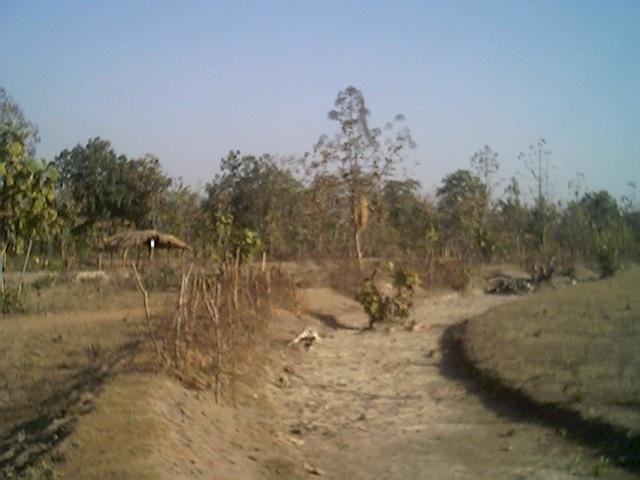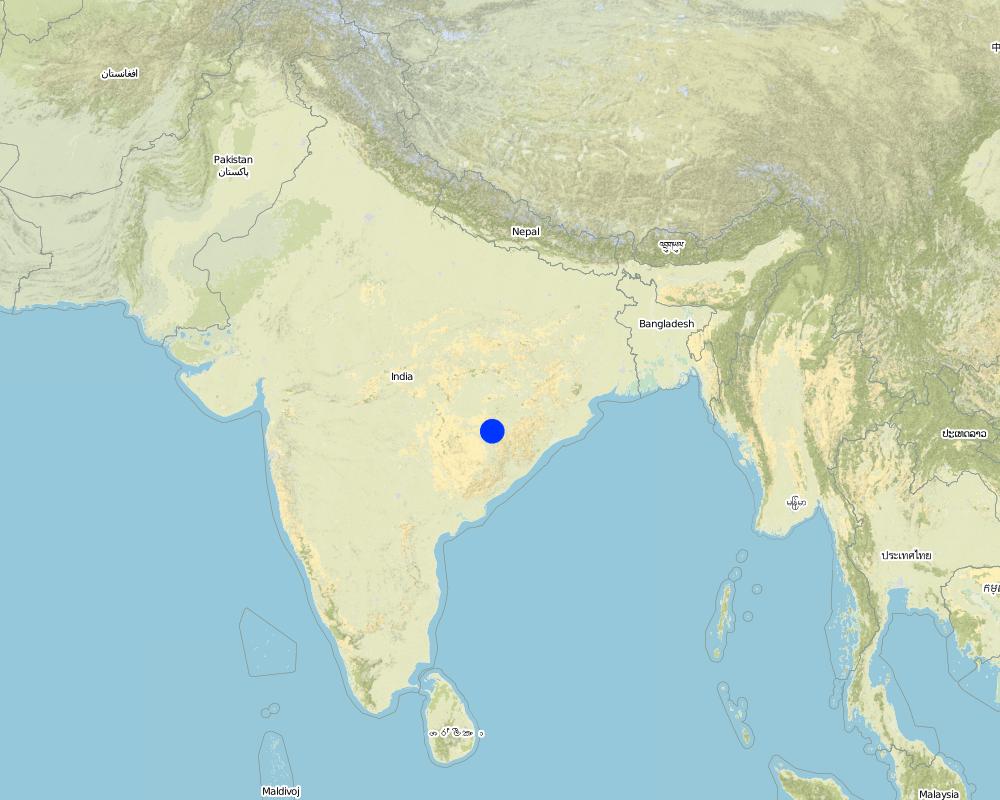Participatory Sustainable Rural Livelihood Approach [印度]
- 创建:
- 更新:
- 编制者: Niranjan Sahu
- 编辑者: –
- 审查者: Fabian Ottiger
approaches_2367 - 印度
查看章节
全部展开 全部收起1. 一般信息
1.2 参与方法评估和文件编制的资源人员和机构的联系方式
SLM专业人员:
有助于对方法进行记录/评估的机构名称(如相关)
Orissa Watershed Developemnt Mission - 印度1.3 关于使用通过WOCAT记录的数据的条件
编制者和关键资源人员接受有关使用通过WOCAT记录数据的条件。:
是
1.4 SLM技术问卷的参考

Contour Trench cum Bund [印度]
Contour trench cum bund is a bund laid out on contour along with trench either staggered or continuous to check the velocity of run off, conserve in situ moisture, increse ground water recharge and there by establish a sustainable land use system.
- 编制者: Niranjan Sahu
2. SLM方法的描述
2.1 该方法的简要说明
Participatory Sustainable Rural Livelihood Approach adopts participatory tools for livelihood situational analysis of the five capitals(Physical, Financila,Social, Human and Natural) and prepare livelihood focussed micro plan with the commuity for sustai
2.2 该方法的详细说明
该方法的详细说明:
Aims / objectives: Participatory Sustainable Rural Livelihood Approach uses the DFID's Sustainable Rural Livelihood Framework. The approach adopts participatory processes during planning, implementation, monitoring and evaluation.The out put of the planning process is a livelihood focussed micro plan. The process of micro plan preparation with the community consists of rapport building, livelihood situational analysis, problem identification and prioritisation, negotiation and development of action plan. The livelihood situational analysis focuses on identifying the strength of the community by diagonising the five capitals(Physical, Natural, Financial, Social, Human) and suggest options for livelihood improvement. Objective: 1.Livelihood improvement of the poor and vulnerable.2. Creating an enabling environment 3. Capacity building of the primary and secondary stake holders.Out puts:1.Enhanced and sustainable livelihood options for resource poor and disadvantaged identified and supported in project areas. 2.Resource poor and disadvantaged organised in project areas to effectively identify, plan and implement livelihood activities and participate in wider for a and processes.3.GO,PRI, NGO,PIA work effectively with communities on (pro poor) livelihoods and initiatives in four project districts. 4.Strategic constraints to livelihood of resource poor and disadvantaged are identified and reviewed and improvements proposed to Government.5.Appropriate approaches and interventions developed through the project are replicated in the four project districts and disseminated within Orissa and national level for a.
Methods: Participatory, Collaborative and Convergence. Stages of implementation: Rapport building,Community mobilistion, Preparation of micro plan, Formation of village level institutions, implementation, monitoring and evaluation.
Role of stakeholders: Community members are actors and all others are facilitators.
2.5 采用该方法的国家/地区/地点
国家:
印度
区域/州/省:
Orissa
Map
×2.6 该方法的开始和终止日期
注明开始年份:
2002
终止年份(若不再采用该方法):
2010
2.7 方法的类型
- 基于项目/方案
2.8 该方法的主要目的/目标
The Approach focused mainly on SLM with other activities (Promotion of tuber crops for food security, Participatory technology development, Livestock management, Grassroot institutions building,Microenterprise development through Self Help Groups, Policy advocacy,Adopt participatory processes)
1.Livelihood of the poorest improved in four districts in a sustainable and replicable way.2.WORLP will provide ENABLING ENVIRONMENT to initiate this experiment.3.Bring about a clear understanding of-what is watershed- (emphasizing equity, social justice and local government / PRI).4.develop a synergistic strategy.5.Orient agencies to work towards the synergistic strategy- capacity building.5.Create and strengthen appropriate institutions at different levels for implementing and monitoring common strategy. 6.Pursue necessary policy change in regards to fund management and inter-department, inter-agency coordination.7.At the grassroots level i.e., watershed level demonstrate convergence of activities.
The SLM Approach addressed the following problems: Capacity building(Knowledge, skill and attitude) of the primary and secondary stake holders.Limited livelihood options.Sectoral approach by line departments.
2.9 推动或妨碍实施本办法所适用的技术的条件
社会/文化/宗教规范和价值观
- 阻碍
Skewed distribution of weath, Community management of natural resources
Treatment through the SLM Approach: Identify well being groups,Promote communty farming, Capacity building on CPR management
财务资源和服务的可用性/可得性
- 阻碍
Poor affordibility of farmers and ownership
Treatment through the SLM Approach: Financial aid to farmers through WC, SHG and UG. Voluntary contribution to create a sense of ownership
机构设置
- 阻碍
Poor grass root institutions
Treatment through the SLM Approach: Strengthening of existing institutions and promotion of WC, SHG, UG and CIG
法律框架(土地使用权、土地和水使用权)
- 阻碍
The existing land ownership, land use rights / water rights hindered a little the approach implementation Due to small land holding
了解SLM,获得技术支持
- 阻碍
poor knowledge on land and water management practices
Treatment through the SLM Approach: In-field training and demonstration, exposure, development of NRM volunteers
3. 相关利益相关者的参与和角色
3.1 该方法涉及的利益相关者及其职责
- 当地土地使用者/当地社区
Village level institutions like WC,SHG,UG,CIG etc.
Working land users were mainly men (mainly main supported by women). Men participate more in WC and UG meetings where as women participate in SHG meetings. The no of women in UG is also less. Decision making is mainly done by men on SWC technology. The resource poor land user is also a member of the UserGroup. So, he/She participate in the meetings and share his/her views.
- NGO
- 国家政府(规划者、决策者)
MoRD,GoI; OWDM,MoA,GoO
- 国际组织
DFID,UK
3.2 当地土地使用者/当地社区参与该方法的不同阶段
| 当地土地使用者/当地社区的参与 | 指定参与人员并描述活动 | |
|---|---|---|
| 启动/动机 | 互动 | Exposure visit and demonstration; Approach is initiated with rapport building stage through small interactive meeting, conducting mapping exercises and focussed group discussion to understand the village situation.Exposure and demonstration help the land users to identify gaps in the existing and im |
| 计划 | 互动 | Mainly: rapid/participatory rural appraisal; partly: public meetings; 1.For livelihood situational analysis. 2. Focussed Group discussion for indepth analyis of constraints and oppertunities of a particular group.3. Palli Sabha to negotiate and obtain a consensus on the plan. |
| 实施 | 外部支持 | Mainly: responsibility for major steps; partly: responsibility for minor steps; Implementation of the programme is the prime responsibility of the user group.NRM volunteers are assisting the UG on technical guidance like laying contours, bunds and trenches.Involved landless during the implementation |
| 监测/评估 | 自我动员 | Mainly: measurements/observations; partly: reporting; Watershed Development Team member and WC check measure the work before payment. The report submitted by the WC is reviewed by the Project implementing agency(PIA). The estimated cost is approved by the committee and then the expenditure is made. |
| Research | 无 |
3.4 有关SLM技术选择的决策
具体说明谁有权决定选择要实施的技术:
- 主要是土地使用者,由SLM专家提供支持
解释:
Interventions promoted mainly on the existing indegeneous practices and based on peoples strength.
Decisions on the method of implementing the SLM Technology were made by mainly by land users supported by SLM specialists. The technical knowhow was transferred to the NRM volunteers and land users through training and demonstration Then the volunteer assisted the land users in developing proposal and implementation of the SWC Technology.
4. 技术支持、能力建设和知识管理
4.1 能力建设/培训
是否为土地使用者/其他利益相关者提供培训?:
是
明确受训人员:
- 土地使用者
- extensionists/trainers (2), SWC specialists (3)
培训形式:
- 在职
- 农民对农民
- 示范区域
涵盖的主题:
Understanding of present land use and future treatment measures, determination of slope, use of tools like A frame, hand level, layout of contours, trench and bund, role of UG etc.
4.2 咨询服务
土地使用者有权使用咨询服务吗?:
是
指明是否提供了咨询服务:
- 在土地使用者的土地上
说明/注释:
Name of method used for advisory service: Participatory technology development, field demonstration, exposure visits and in field training; Key elements: Use of participatory tools, NRM volunteers, Insitu training, demonstration and exposure visits; 1) Mainly: NRM volunteers, Partly: projects own extension structure and agent 2) Mainly: NRM volunteers, Partly: projects own extension structure and agent; Extension staff: specifically hired project employees 3) Target groups for extension: land users; Activities: Meeting, exposure,training and demonstration
Advisory service is inadequate to ensure the continuation of land conservation activities; Five NRM volunteers have been created in each watershed to assist in SWC work.Three WDT and three LST have been in position for extension and awareness creation among the land users for ten watersheds.
4.3 机构强化(组织发展)
是否通过这种方法建立或加强了机构?:
- 是,适度
具体说明机构的强化或建立程度:
- 本地
具体说明支持类型:
- 财务
- 能力建设/培训
4.4 监测和评估
监测和评估是该方法的一部分吗?:
是
注释:
bio-physical aspects were ad hoc monitored through observations
technical aspects were regular monitored through observations
socio-cultural aspects were ad hoc monitored through observations
economic / production aspects were regular monitored through measurements
area treated aspects were regular monitored through observations
no. of land users involved aspects were regular monitored through measurements
management of Approach aspects were regular monitored through observations
There were several changes in the Approach as a result of monitoring and evaluation: Focussing the poorest through well being grouping for livelihood improvement, Grant component for the poorest earmarked in the livelihood guideline from watershed plus funds,Block approach for treatment considering poor people, poor land, contributiona nd ridge to valley, developed livelihood focussed micr plan process for the project.Transperency through social audit.
4.5 研究
研究是该方法的一部分吗?
是
明确话题:
- 经济/市场营销
- 技术
提供进一步的细节,并指出是谁做的研究:
Participatory technology development in farmers field.MART, New Delhi has taken up a six months study on developing marketing strategy.
Research was carried out on-farm
5. 融资和外部物质支持
5.1 该方法中SLM组成部分的年度预算
如果不知道准确的年度预算,请给出一个范围:
- > 1,000,000
注释(例如主要的资助来源/主要捐助者):
Approach costs were met by the following donors: international (DFID,UK): 85.0%; local community / land user(s) (UG): 15.0%
5.2 为土地使用者提供财政/物质支援
土地使用者是否获得实施该技术的财政/物质支持?:
否
5.3 对特定投入的补贴(包括劳动力)
- 无
如果土地使用者的劳动力是一项重要的投入,那么是不是:
- 以现金支付
5.4 信用
是否根据SLM活动的方法给予信用值?:
否
6. 影响分析和结论性陈述
6.1 方法的影响
该方法是否帮助土地使用者实施和维护SLM技术?:
- 否
- 是,很少
- 是,中等
- 是,支持力度很大
treating the land from ridge to valley,reduced soil loss and sand casting in the down stream, increased moisture availabilty, water harvesting of the excess runoff,
该方法是否改善了阻碍SLM技术实施的土地使用权/用户权问题?:
- 否
- 是,很少
- 是,中等
- 是,支持力度很大
Working in group in a participatory manner has facilitated a process of identifying their own constraints and oppertunities and plan interventions accordingly, thus implamentation is more effective.
Did other land users / projects adopt the Approach?
- 否
- 是,很少
- 是,中等
- 是,支持力度很大
Adoption of the SRL approach and compact area treatment in non-WORLP watersheds in WORLP project districts.
6.3 方法活动的可持续性
土地使用者能否维持通过该方法实施的措施(无外部支持的情况下)?:
- 是
6.4 该方法的长处/优点
| 土地使用者眼中的长处/优势/机会 |
|---|
| We are working together (How to sustain/ enhance this strength: Ugs and SHGs be promoted in amore democratic way) |
| It is our work (How to sustain/ enhance this strength: Feeling of ownership needs to be strengthed) |
| We have been able to practise the SWC activity in a better way (How to sustain/ enhance this strength: Exposure to learn more about SWC activities.) |
| 编制者或其他关键资源人员认为的长处/优势/机会 |
|---|
| Community take their own decision (How to sustain/ enhance this strength: making the institutions more democratic) |
| Revolving fund (How to sustain/ enhance this strength: Increased frequency of internal lending and repayment) |
| Village level institutions (How to sustain/ enhance this strength: provide autonomy) |
| Village volunteers/link workers (How to sustain/ enhance this strength: capacity building) |
6.5 该方法的弱点/缺点以及克服它们的方法
| 编制者或其他关键资源人员认为的弱点/缺点/风险 | 如何克服它们? |
|---|---|
| Poverty categorisation based on criteria developed by the community | Criteria has already been developed nad circulated |
| Difficult to address all the issues of livelihood within the project time frame | Strategy needs to be developed for better convergence with line department to expedite the process |
7. 参考和链接
7.1 方法/信息来源
- 实地考察、实地调查
- 与土地使用者的访谈
7.2 参考可用出版物
标题、作者、年份、ISBN:
Success stories compilation, News letter, Project memorandum, Livehood microplan of watershed
可以从哪里获得?成本如何?
Project Director(Watershed), Nuapada Project Director(Watershed)
链接和模块
全部展开 全部收起链接

Contour Trench cum Bund [印度]
Contour trench cum bund is a bund laid out on contour along with trench either staggered or continuous to check the velocity of run off, conserve in situ moisture, increse ground water recharge and there by establish a sustainable land use system.
- 编制者: Niranjan Sahu
模块
无模块


